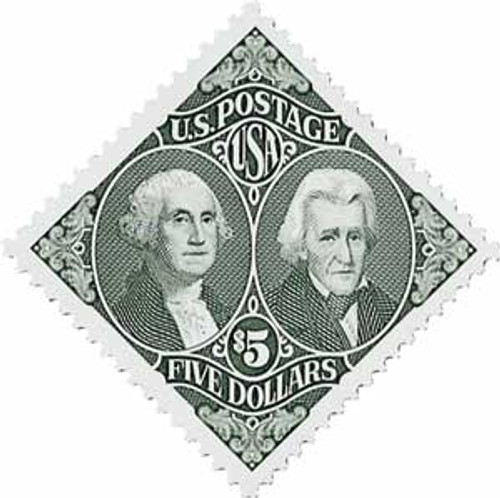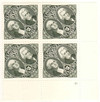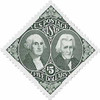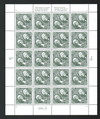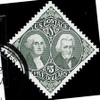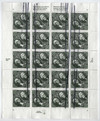
# 2592 - 1994 $5 Washington and Jackson
US #2592
1994 Washington and Jackson
- Based on a 19th century stamp essay
- Pictures two famous Presidents
- One of the few diamond-shaped US stamps
Category of Stamp: Definitive
Value: $5
First Day of Issue: August 19, 1994
First Day City: Pittsburgh, Pennsylvania
Quantity Issued: 100,000,000
Printed by: Stamp Venturers
Printing Method/Format: Engraved. Panes of 20 from plates of 120 (8 across, 15 down)
Perforations: 11.5
Color: Slate Green
Reason the stamp was issued: This stamp honors two of America’s most famous Presidents. It was issued with stamp collectors in mind.
About the stamp design: The design for the stamp is based on a 19th century essay. The original stamp was also oriented as a diamond. The first diamond stamp was issued in the US a century later. Yves Baril engraved the modern Washington and Jackson stamp. He had previously created the artwork for two Great Americans stamps.
The image of Washington is taken from a portrait by Gilbert Stuart. It was reversed to make Washington face right instead of left. Jackson’s image is based on a portrait by John Wood Dodge.
First Day City: The First Day of Issue took place during an August 19 American Philatelic Society meeting.
US #2592
1994 Washington and Jackson
- Based on a 19th century stamp essay
- Pictures two famous Presidents
- One of the few diamond-shaped US stamps
Category of Stamp: Definitive
Value: $5
First Day of Issue: August 19, 1994
First Day City: Pittsburgh, Pennsylvania
Quantity Issued: 100,000,000
Printed by: Stamp Venturers
Printing Method/Format: Engraved. Panes of 20 from plates of 120 (8 across, 15 down)
Perforations: 11.5
Color: Slate Green
Reason the stamp was issued: This stamp honors two of America’s most famous Presidents. It was issued with stamp collectors in mind.
About the stamp design: The design for the stamp is based on a 19th century essay. The original stamp was also oriented as a diamond. The first diamond stamp was issued in the US a century later. Yves Baril engraved the modern Washington and Jackson stamp. He had previously created the artwork for two Great Americans stamps.
The image of Washington is taken from a portrait by Gilbert Stuart. It was reversed to make Washington face right instead of left. Jackson’s image is based on a portrait by John Wood Dodge.
First Day City: The First Day of Issue took place during an August 19 American Philatelic Society meeting.

